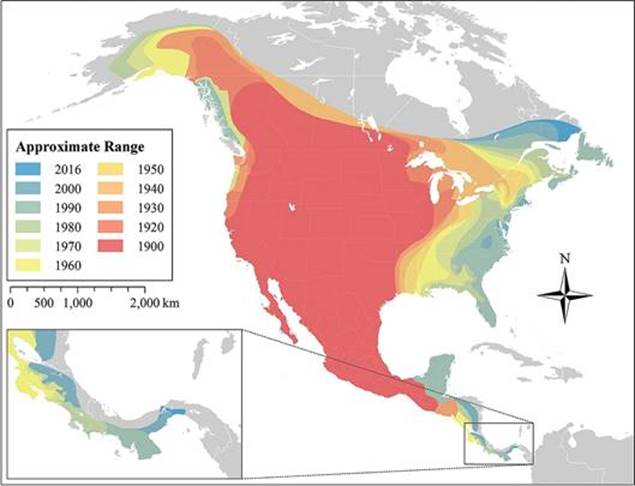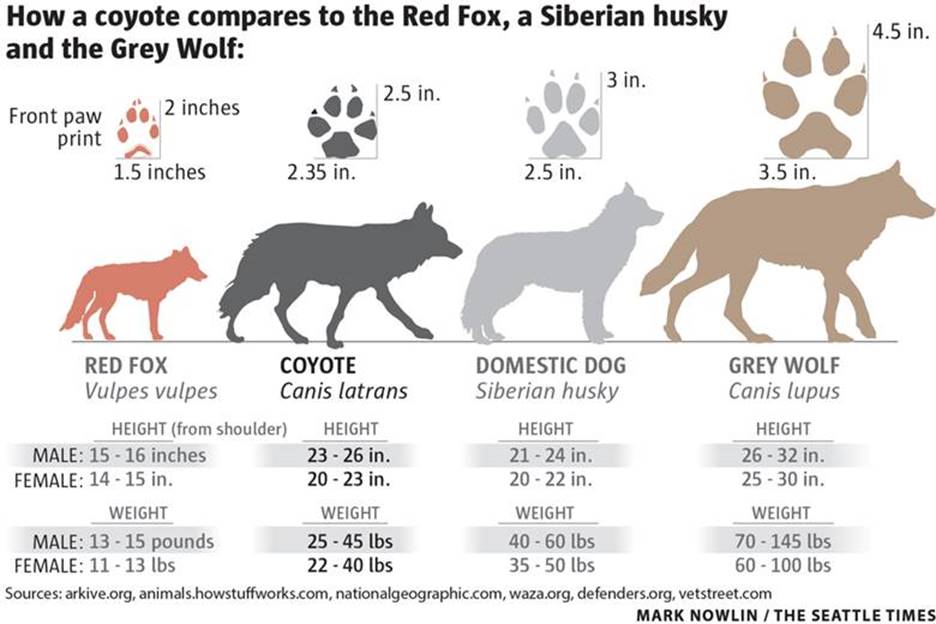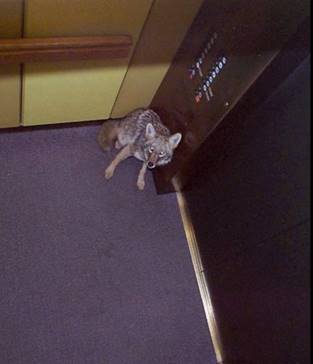Darkness fell and now Coyote listened for the voices and he looked all round, he looked here
and there, but nothing appeared. Coyote sat there in the middle of the prairie. He sat there all
night but the lodge didn’t appear again nor did the ghost ever return to him. From Nez Perce mythology, Coyote and the Shadow People.
These days, just ask anyone of your friends where they have recently seen a coyote and they will promply tell you. They are increasingly common in cities, suburbs, and certainly rural areas. It was not always like this.
When Europeans first came to North America much of the east coast was covered in dense forest and coyotes were largely restricted to the open plains and arid plains of the west. Lewis and Clarke came across coyotes a number of times during their journey across the continent but it was not until 1819 that the species was fully described by Thomas Say during his 1819-1820 exploration of the Rocky Mountains as part of the Harriman expedition. Say helped found the Philadelphia Academy of Natural Sciences and first recorded and number of birds, mammals, lizards, and reptiles in North America. The Say’s phoebe is one named after him.
Land conversion and the extirpation of wolves from the North American landscape allowed coyotes to fill that ecological niche without competition. An interesting experiment took place when wolves were first reintroduced into Yellowstone National Park in 1995. Coyotes were widespread in the park but once wolves were reintroduced their numbers decreased significantly. Apparently elk were not intimidated by the coyotes but became much warier when the wolves returned. With wolves around, the elk changed their habitat use patterns and moved out of the tasty riparian areas and spent more time in the surrounding forest and high ground. Since wolves were reintroduced these riparian areas have become increasingly healthy, beaver have moved back, and the system is in better balance.

Coyotes are smaller than wolves, have a thinner build, and a longer snout and ears. Their fur can vary in color and texture depending upon where they live. Generally, coyotes are light gray with areas of black and white. Males average 18 – 44 lbs. while females are about 15 – 40 lbs. Northern subspecies tend to be larger. The record for largest coyote is held by one killed in Wyoming in 1937 that was 75 lbs.
The name coyote is a twist on the Spanish interpretation of a Nahualtl Tribal name for the animal – coyotl. And the scientific name, Canis latrans is from the Latin Canis – dog, latrans – barking.
In the northeast U.S. and southern Canada coywolves – hybrids between wolves and coyotes are frequently observed. Female coywolves weigh and average 35% more than coyotes.
In many Native American cultures, the coyote is credited with bringing humanity the gift of fire, the destruction of monsters, the making of waterfalls, and the teaching of useful arts to the Indians. In the Nez Perce tribe’s myth of Coyote and the Shadow People his actions lead to humankind being forever separated from the spirit realm of the dead. More recently an America mythology has provided many stories of the coyote as an unsuccessful trickester

The immediate family is the main social unit for coyotes, though they will form larger groups for socialization or to bring down larger prey. Coyotes are monogamous and females that fail to mate may assist a sister or their mother with their offspring. Dens are located in burrows, under fallen trees, in rock ledges or wherever there is a dry and secure refuge. The average litter is six young although this changes with population density and available prey. The young are altricial – born helpless and with eyes closed, depending on their mother’s milk for at least 10 days. Both parents help raise the litter. The pups will hang with the parents until the end of summer and then fend for themselves.
About 90% of their diet is meat, but the range of what they will eat is quite impressive and includes rabbits, rodents, birds, lizards, snakes, turtles, amphibians, fish, crustaceans, and insects. What’s left? Once while working up in Alaska I saw a large snowshoe hare hop into the brush and shortly later a coyote scooted by. My colleague started to ask “Do you think that coyote would go after such a big hare?” But before he finished the coyote came lopping back with the hare in his mouth.
Coyotes that inhabit cities and suburbs make use of the amble supply of pets. Work in California indicates that coyotes heavily depend on pets as a source of food during the winter and spring. Every once in a while a sign appears on telephone poles in my neighborhood with the same message – “Warning – A Coyote Ate My Cat!”
Maybe because they are now treated more like a curiosity than vermin, coyotes in urban areas are less intimidated by people and can sometimes act aggressively, chasing bicyclists and joggers, confronting people walking their dog, or stalking small children. It does not help when people feed them. My suggestion – if you see one in your neighborhood clap and hoot at them to keep them wary. There are, however, creative pet protection measures
In 1997 a coyote was running around downtown Seattle and was getting harassed by crows. He panicked and ran towards the old Federal Building, into the lobby, and into an open elevator as the door closed behind him. Some animal control folks picked him up and released him in a more appropriate spot.

I saw a coyote this past weekend in Seattle’s small Ravenna Park as he scampered through and open field and disappeared down a footpath. A friend recently let me know about this carnivore mapping project for the Puget Sound region where you can view sightings (many have uploaded photos and videos). Coyotes are the most frequently seen carnivore. While there is a video of a bobcat in my neighborhood I’m doubting the cougar siting. https://carnivorespotter.org/ (Use Chrome to view)
Coyotes are quite vocal and exhibit a wide range of sounds including barks, yips, howls, and high-frequency whines. I suppose they could get a bit annoying if you had an open space next door and they were constantly cavorting in the summer, but when camping it has that reassuring measure while you are settling down for the evening.
A couple of decades ago I was camping with my daughter in eastern Washington in the Potholes, an area scrapped out by the great Ice Age Floods. We were walking a dirt road through the sagebrush hills back to our campsite when the coyotes started singing about a half mile away. So I suggested we sing back.
We found a hill, cupped our hands to our mouth, and yipped and howled for a few minutes. We paused. All was silent. We let another five minutes go by and were getting ready to walk back to camp when the chorus started again. This time they were less than 100 yards away. Chloe turned to me and said “Should we run?” I had to reassure her that it wasn’t necessary. We walked back as the coyote sounds drifted away and they went on to other night business.

Hi Jim,
I saw your post on AG and your ecologist background caught my eye, esp. progress on wildlife encounters around the world. Excellent piece here on coyote, written for those of us who never took to our biology classes.
I’m close to completing a sequel novel, featuring a coyote pup hanging around an AZ golf course and the two young adults who become involved with him and themselves. When you have a moment, you can find me at ……
Author of Wild Call to Boulder Field–An Arizona Trail Adventure
Fiction Finalist: Dog Writers of America 2023 Contest
http://www.RobertRonningAuthor.com
Perhaps we could do beta reads down the line?
Robert
Interesting! Could be interested in beta read trading in near future. I’m soon off to Madagascar for a month as a volunteer researcher, then another three weeks in South Africa/Botswana. Will be posting some essays here. So early July back in town and turning attention to bookin progress